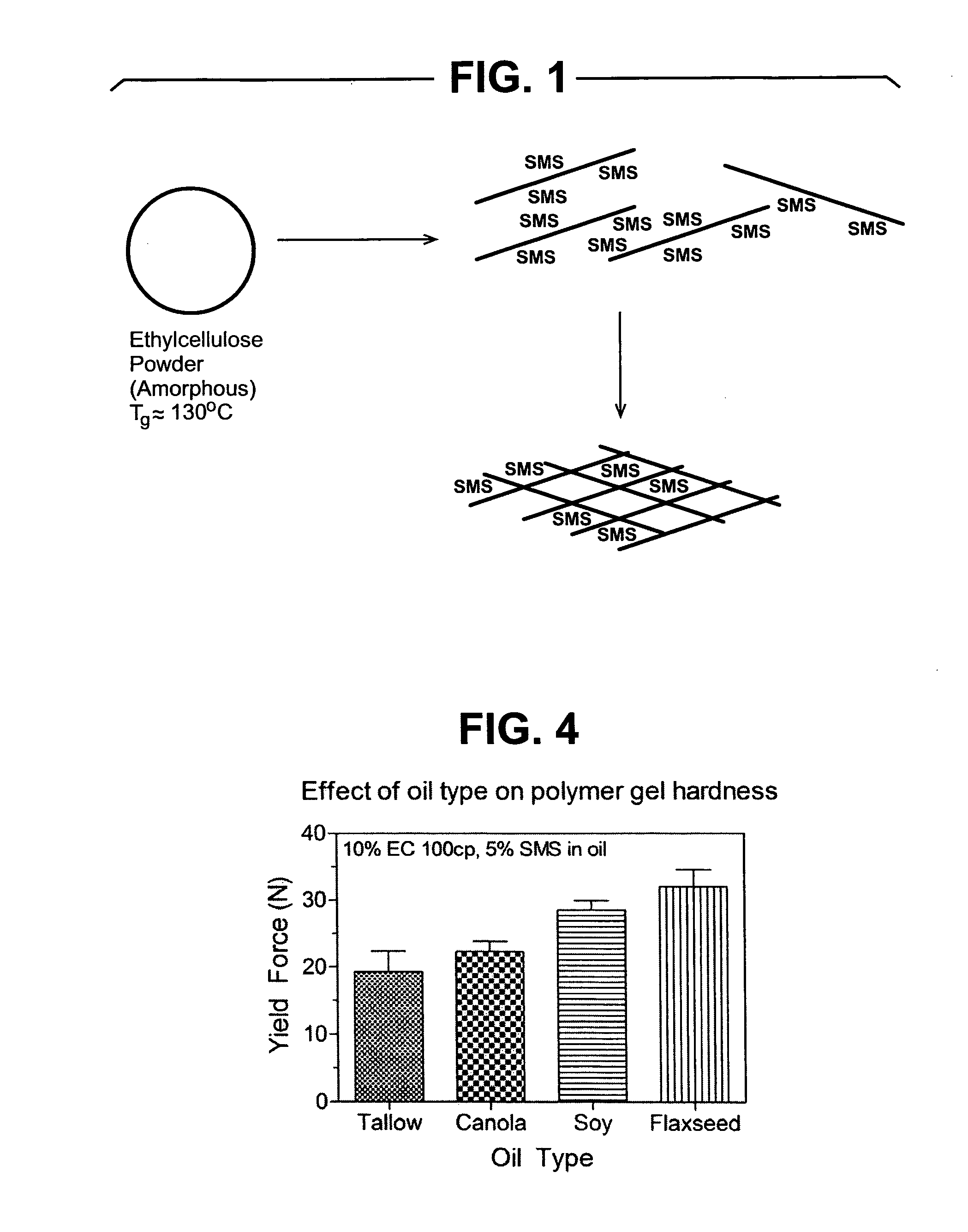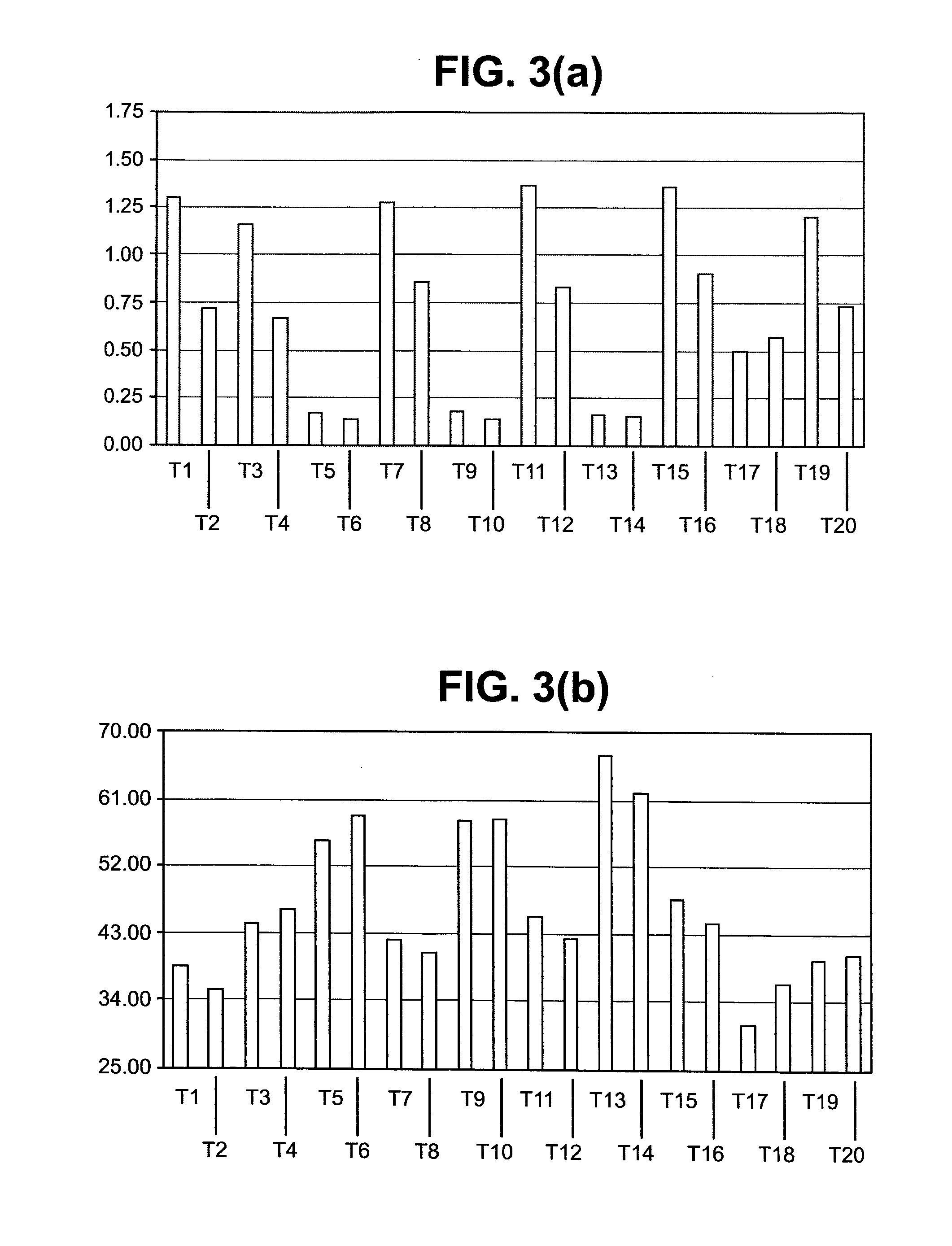Polymer gelation of oils
a technology of polymer and oil, applied in the field of oils, can solve the problems of increasing the incidence of cancer, heart disease, and high consumption of trans fatty acids, and achieve the effect of preventing syneresis and reducing the amoun
- Summary
- Abstract
- Description
- Claims
- Application Information
AI Technical Summary
Benefits of technology
Problems solved by technology
Method used
Image
Examples
example 1
[0057]In one embodiment, a fat substitute is prepared as follows. Ethylcellulose 22 cp or 45 cp 9 % w / w (ETHOCEL®, Dow Chemical Co.) and 3% w / w SMS in a 30:70 w / w mixture of 5 fully hydrogenated soybean oil with liquid soybean oil were heated up 140° C. to ensure full solubilization of the polymer in oil. Upon cooling of the melt, at 100° C., soybean oil heated to 100° C. was added at a 1:2 ratio (1 / 3 dilution). The final concentration of components was 6% EC, 2% SMS, 20% fully hydrogenated soybean oil and 72% soybean oil. The mixture was then allowed to cool down and set. Fully hydrogenated cottonseed oil, fully hydrogenated canola oil, beef tallow, lard, milkfat could also be added as the hardstock. This material has the functionality and texture of a fat.
example 2
[0058]In another embodiment, a fish oil gel for ruminant feeing is provided. Ethylcellulose 22 cp or 45 cp 9 % w / w (source as in Example 1) and 3 % w / w SMS in a 30:70 w / w mixture of fully hydrogenated soybean oil with liquid soybean oil were heated up 140° C. to ensure full solubilization of the polymer in oil. Upon cooling of the melt, at 90° C., fish or algal oil heated to 90° C. was added under reduced pressure or under a nitrogen blanket at a 1:2 ratio (1 / 3 dilution). The final concentration of components was 6% EC, 2% SMS, 20% fully hydrogenated soybean oil and 72% fish or algal oil. The material was hard enough that it could be cut into small pieces by chopping for inclusion into animal feed. Supplementation of cow feed with stabilized fish oil will protect the fish oil from biohydrogenation in the rumen of the cow, and thus allow the cow to accumulate DHA and EPA in the milk produced. Naturally secreted milk has a great potential as a source of long-chain omega-3 fatty acids....
example 3
[0059]In a further embodiment, a 10% ethylcellulose 22 cp gel containing 5% sorbitan monostearate in flaxseed oil was prepared. The gel was prepared by the thermal treatment described above and allowed to set at 22° C. for one day. The rheological test results show that the test gel is very solid-like (firm gel), with a G′ / G″ value of about 4 at 1 Hz. The yield stress of the gel was 100-300 Pa.
PUM
 Login to View More
Login to View More Abstract
Description
Claims
Application Information
 Login to View More
Login to View More - R&D
- Intellectual Property
- Life Sciences
- Materials
- Tech Scout
- Unparalleled Data Quality
- Higher Quality Content
- 60% Fewer Hallucinations
Browse by: Latest US Patents, China's latest patents, Technical Efficacy Thesaurus, Application Domain, Technology Topic, Popular Technical Reports.
© 2025 PatSnap. All rights reserved.Legal|Privacy policy|Modern Slavery Act Transparency Statement|Sitemap|About US| Contact US: help@patsnap.com



